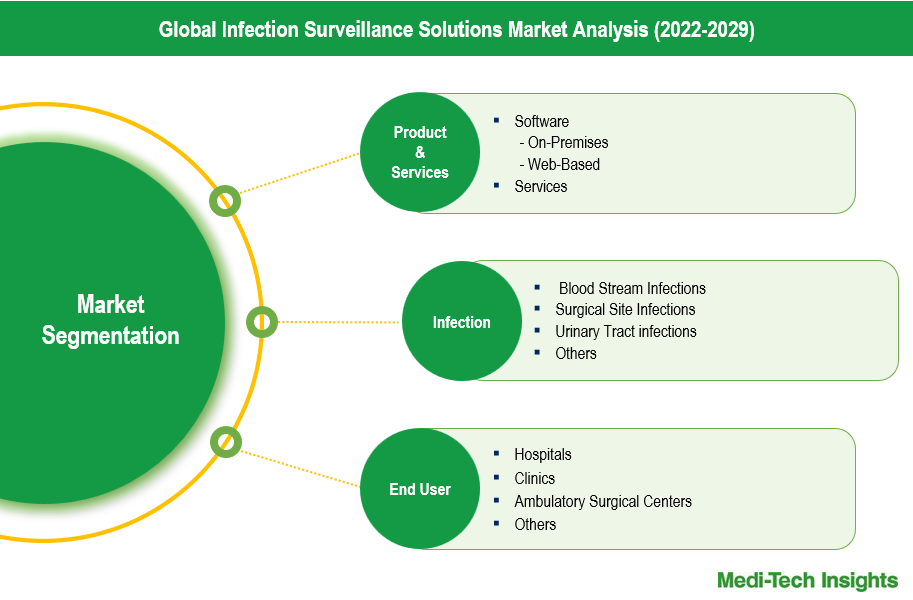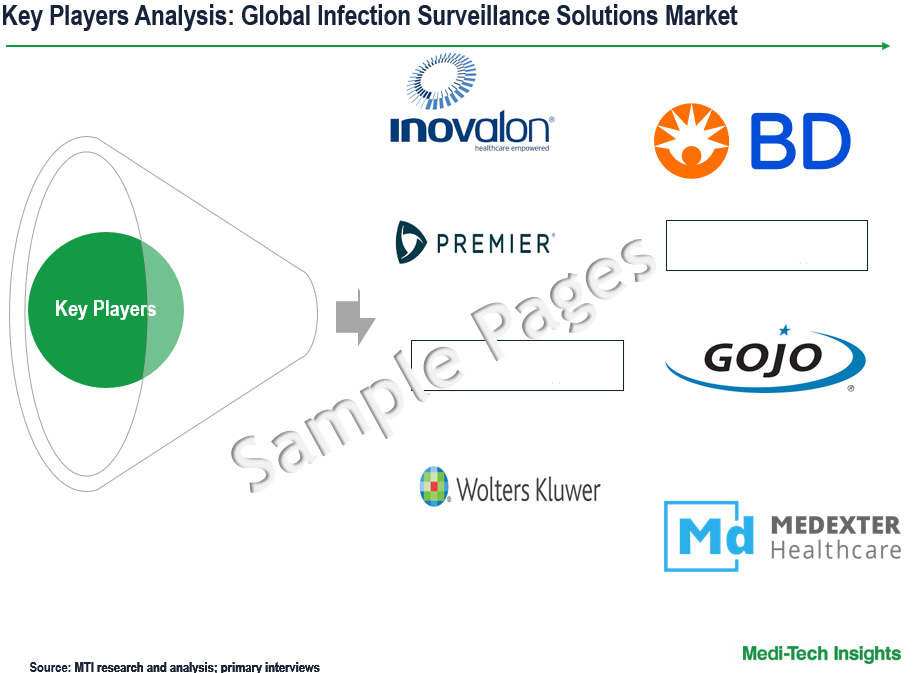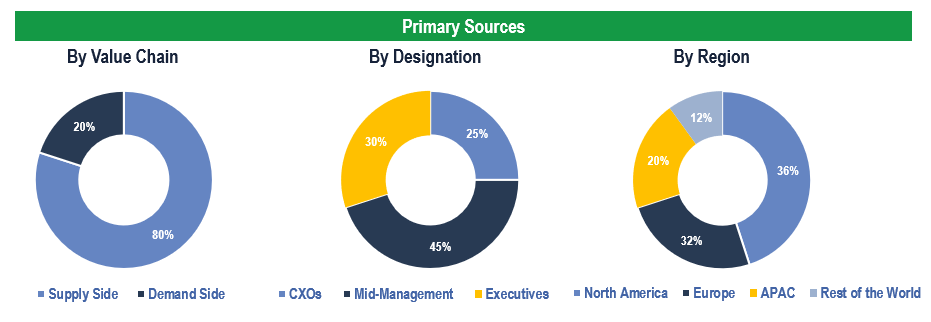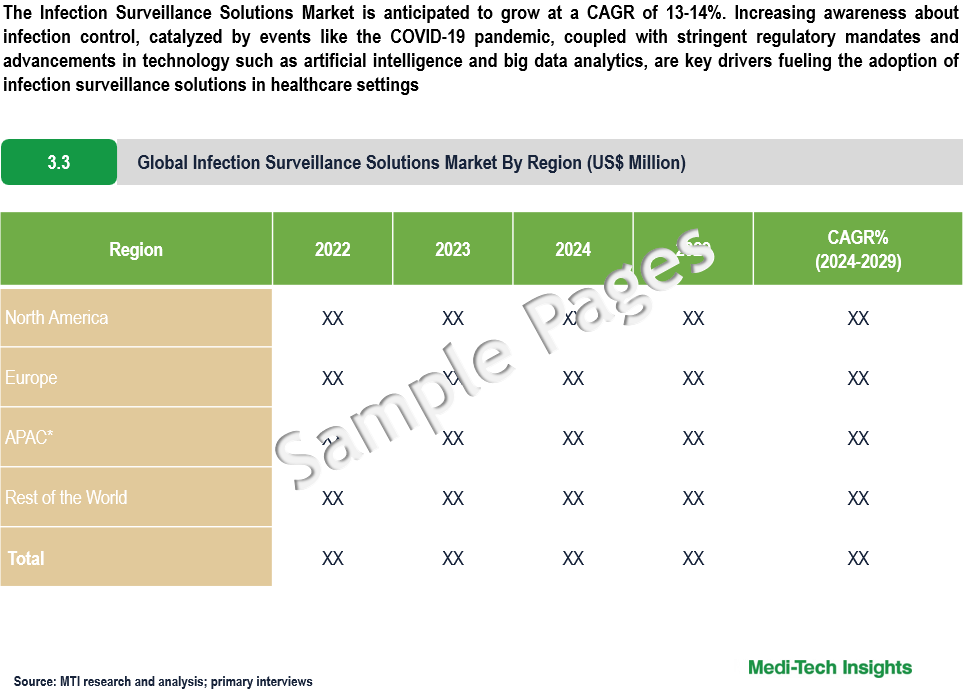
Infection Surveillance Solutions Market Size, Share, Trends, and Opportunities for Forecast 2024 to 2029
The Infection Surveillance Solutions Market is anticipated to grow at a CAGR of 13-14%. Increasing awareness about infection control, catalyzed by events like the COVID-19 pandemic, coupled with stringent regulatory mandates and advancements in technology such as artificial intelligence and big data analytics, are key drivers fueling the adoption of infection surveillance solutions in healthcare settings. To learn more about the research report, download a sample report.
Infection surveillance refers to the systematic monitoring, tracking, and analysis of data related to infectious diseases within healthcare settings or communities. It involves gathering information from various sources such as electronic health records, laboratory reports, and public health databases to detect and monitor the spread of infections, identify outbreaks, and implement timely interventions. By continuously tracking trends and patterns, infection surveillance helps healthcare professionals and public health authorities respond effectively to emerging threats, allocate resources efficiently, and implement preventive measures to control the spread of diseases.
Enhancing Healthcare: Infection Surveillance Solutions
Infection surveillance solutions encompass a range of tools and technologies designed to facilitate effective monitoring, tracking, and prevention of infectious diseases. These solutions typically involve real-time monitoring of data streams from electronic health records, laboratory reports, and syndromic surveillance systems to detect unusual patterns or spikes in infections. They integrate data from multiple sources, including clinical, laboratory, and environmental data, to provide a comprehensive view of infection trends and facilitate informed decision-making. Advanced solutions may employ predictive analytics and machine learning algorithms to forecast potential outbreaks and optimize preventive measures. Additionally, these systems generate alerts and reports to notify healthcare professionals and public health authorities about emerging threats, support epidemiological investigations, ensure compliance with regulatory requirements, and offer customization and scalability to meet the specific needs of different healthcare settings. Thereby helping healthcare facilities track and prevent the spread of infections among patients and staff, ultimately improving patient outcomes and reducing healthcare costs.

To learn more about this report, download the PDF brochure
Infection Surveillance Solutions: Exploring Growth Drivers and Opportunities
The landscape of infection surveillance solutions, particularly in healthcare, is experiencing remarkable expansion driven by several pivotal factors and promising opportunities. First and foremost, there is a rising awareness regarding infection control and prevention, particularly emphasized by the emergence of the COVID-19 pandemic, highlighting the imperative for robust surveillance systems. Additionally, stringent regulatory mandates mandate the integration of infection surveillance solutions within healthcare settings, propelling their adoption to ensure compliance. Furthermore, technological strides, including the integration of artificial intelligence, machine learning, and big data analytics, are augmenting the efficacy of these solutions, enabling real-time monitoring and predictive analytics. This technological evolution aligns with the broader trend of increasing healthcare expenditure globally, particularly in emerging economies, driving investment in advanced healthcare technologies like infection surveillance. For instance,
- In November 2022, Wolters Kluwer expanded its Sentri7 suite with the Sentri7 Sepsis Monitor, utilizing advanced algorithms and clinical natural language processing to enable continuous surveillance for early sepsis detection, adherence to the SEP-1 protocol, and improved patient care and financial outcomes in hospitals and health systems.
- In June 2022, Premier introduced PINC AI™, a clinical surveillance technology tailored for long-term care facilities to address COVID-19-related challenges and beyond, offering real-time infection prevention and management solutions for healthcare professionals
Concurrently, there's a growing emphasis on patient safety, with infection surveillance solutions playing a pivotal role in identifying and mitigating healthcare-associated infections. The burgeoning healthcare data analytics market further amplifies growth prospects by facilitating data-driven decision-making. Moreover, ongoing global health threats, such as pandemics and antimicrobial resistance, accentuate the necessity for effective surveillance, presenting opportunities for innovative solutions to address evolving healthcare needs.
Advancing Strategies in Infectious Disease Surveillance
In the dynamic landscape of infectious disease surveillance, several trends are shaping the evolution of solutions. Integration of AI and machine learning elevates detection accuracy and outbreak prediction, while real-time data analytics enables swift identification of emerging threats. Mobile and wearable technologies empower remote data collection and proactive monitoring, complemented by blockchain's secure data storage. Predictive analytics forecasts disease spread, facilitating proactive interventions, while interoperability and data sharing foster comprehensive insights and coordinated responses. Telemedicine supports remote patient monitoring, and global collaboration drives standardization for enhanced preparedness. These trends underscore the vital role of advanced technologies and collaborative endeavours in safeguarding public health against infectious diseases. Additionally, the utilization of genetic sequencing and bioinformatics tools is enhancing pathogen tracking and characterization, aiding in the identification of novel pathogens and tracking their spread. In conclusion, the convergence of advanced technologies, collaborative efforts, and innovative approaches is revolutionizing infectious disease surveillance, empowering healthcare systems worldwide to proactively identify, monitor, and respond to emerging threats, ultimately safeguarding public health on a global scale.
Key Constraints / Challenges
Infection surveillance solutions face several challenges that hinder their effectiveness and implementation in healthcare settings. Ensuring the quality and integration of data from various sources, including electronic health records and laboratory reports, presents a significant hurdle, compounded by concerns over patient privacy and data security. Resource constraints, both financial and skilled labour, may limit the adoption and maintenance of these systems, particularly in resource-limited environments. Technological barriers, such as infrastructure inadequacies and usability issues, further complicate implementation efforts.

To learn more about this report, download the PDF brochure
Product & Services Outlook
The infection surveillance solutions market offers a range of products and services, primarily categorized into software and services. In 2023, the software segment, comprising both on-premise and web-based software, dominated the market with a significant share. However, the services segment is projected to exhibit a higher growth rate during the forecast period, driven by its growing demand within healthcare facilities. Among the sub-categories of software, web-based software is poised to witness the most substantial expansion, driven by its availability in diverse configurations, rapid return on investment, and capability for real-time analysis. As the market evolves, the integration of advanced technologies and services will continue to play a vital role in enhancing infection surveillance efforts and bolstering public health preparedness.
Navigating Regional Variances: Adoption Trends of Infection Surveillance Solutions
With robust healthcare infrastructure and advanced technology adoption, North America leads in the implementation of infection surveillance solutions. Stringent regulatory requirements, such as those imposed by the CDC in the United States, drive the adoption of these solutions. Europe also exhibits strong adoption of infection surveillance solutions, supported by comprehensive healthcare systems and a focus on patient safety. Regulatory frameworks, such as the European Centre for Disease Prevention and Control (ECDC), promote standardized surveillance practices across the region. However, variations in healthcare systems and data privacy regulations among European countries can present challenges to seamless integration and interoperability of surveillance systems.
The Asia-Pacific region is witnessing increasing adoption of infection surveillance solutions, driven by rising healthcare expenditure, growing awareness about infection control, and government initiatives to improve healthcare infrastructure. However, disparities in healthcare access, limited resources in some areas, and diverse regulatory landscapes pose challenges to widespread implementation. Cultural factors and varying levels of technological advancement also influence adoption rates across countries in this region. Overall, regional segmentation analysis highlights the diverse landscape of infection surveillance solutions, influenced by factors such as regulatory frameworks, healthcare infrastructure, economic conditions, and cultural norms. Despite challenges, efforts to strengthen surveillance capabilities are underway across regions to mitigate the impact of infectious diseases and improve public health outcomes.
Competitive Landscape
The prominent players in the infection surveillance solutions market include IBM Corporation, Premier, Inc., BioMérieux SA, Vigilanz Corporation, Truven Health Analytics (IBM Watson Health), Becton, Dickinson and Company (BD), Wolters Kluwer N.V., Baxter International Inc., RL Solutions (a part of RLDatix), and Medexter Healthcare among others

Get a sample report for competitive landscape analysis
Organic and Inorganic Growth Strategies Adopted by Players to Establish Their Foothold in the Market
Players operating in this market are adopting both organic and inorganic growth strategies such as collaborations, and acquisitions to garner market share. For instance,
- In February 2024, Inovalon, a provider of cloud-based software solutions, revealed its acquisition of VigiLanz, a company specializing in SaaS-based clinical surveillance and patient safety software and data
- In August 2022, Blessing Health System (Blessing) chose POC Advisor* from Wolters Kluwer, Health, to swiftly identify and provide optimal care for patients experiencing sepsis or septic shock, expanding its employment of Wolters Kluwer's clinical surveillance suite alongside Sentri7 infection prevention and pharmacy surveillance solutions
The Infection Surveillance Solutions Market is anticipated to grow due to the increasing prevalence of healthcare-associated infections (HAIs), growing awareness of the importance of infection control measures, and advancements in technology allowing for more efficient and accurate surveillance, along with strategic partnerships and collaborations, will further propel market growth and innovation in the coming years.
| Report Scope | Details |
| Base Year Considered | 2023 |
| Historical Data | 2022 - 2023 |
| Forecast Period | 2024 - 2029 |
| CAGR (2024 - 2029) | 13-14% |
| Segment Scope | Product & Services, Infection, End User |
| Regional Scope |
|
| Key Companies Mapped | IBM Corporation, Premier, Inc., BioMérieux SA, Vigilanz Corporation, Truven Health Analytics (IBM Watson Health), Becton, Dickinson and Company (BD), Wolters Kluwer N.V., Baxter International Inc., RL Solutions (a part of RLDatix), and Medexter Healthcare |
| Report Highlights | Market Size & Forecast, Growth Drivers & Restraints, Trends, Competitive Analysis |
Key Strategic Questions Addressed
-
What is the market size & forecast for the Global Infection Surveillance Solutions Market?
-
What are the historical, present, and forecasted market shares and growth rates of various segments and sub-segments of the Global Infection Surveillance Solutions Market?
-
How has COVID-19 impacted the Global Infection Surveillance Solutions Market?
-
What are the major growth drivers, restraints/challenges impacting the market?
-
What are the opportunities prevailing in the market?
-
What is the investment landscape?
-
Which region has the highest share in the global market? Which region is expected to witness the highest growth rate in the next 5 years?
-
Who are the major players operating in the market? What is the competitive positioning of key players?
-
Who are the new players entering the market?
-
What are the key strategies adopted by players?
- Research Methodology
- Secondary Research
- Primary Research
- Market Estimation
- Market Forecasting
- Executive Summary
- Market Overview
- Market Dynamics
- Drivers
- Restraints
- Opportunities
- Market Dynamics
- Global Infection Surveillance Solutions Market - Size & Forecast (2021-2028), By Product & Services
- Software
- On-Premises
- Web-Based
- Services
- Software
- Global Infection Surveillance Solutions Market - Size & Forecast (2021-2028), By Infection
- Blood Stream Infections
- Surgical Site Infections
- Urinary Tract Infections
- Others
- Global Infection Surveillance Solutions Market - Size & Forecast (2021-2028), By End User
- Hospitals
- Clinics
- Ambulatory Surgical Centers
- Others
- Global Infection Surveillance Solutions Market - Size & Forecast (2021-2028), By Region
- North America (U.S. & Canada)
- Europe (UK, Germany, France, Italy, Spain, Rest of Europe)
- Asia Pacific (China, India, Japan, Rest of Asia Pacific)
- Rest of the World (Latin America, Middle East & Africa)
- Competitive Landscape
- Key Players and their Competitive Positioning
- Competitive Positioning of Key Players (2022)
- Offerings Assessment, By Players
- Key Strategies Assessment, By Player (2021-2023)
- New Product Launches
- Partnerships, Agreements, & Collaborations
- Mergers & Acquisitions
- Other Developments
- Key Players and their Competitive Positioning
- Key Companies Scanned (Indicative List)
- IBM Corporation
- Premier, Inc.
- BioMérieux SA
- Vigilanz Corporation
- Becton, Dickinson and Company (BD)
- Wolters Kluwer N.V.
- Baxter International Inc.
- RL Solutions (a part of RLDatix)
- Medexter Healthcare
- Other Players
The study has been compiled based on extensive primary and secondary research.
Secondary Research (Indicative List)

Primary Research
To validate research findings (market size & forecasts, market segmentation, market dynamics, competitive landscape, key industry trends, etc.), extensive primary interviews were conducted with both supply and demand-side stakeholders.
Supply Side Stakeholders:
- Senior Management Level: CEOs, Presidents, Vice-Presidents, Directors, Chief Technology Officers, Chief Commercial Officers
- Mid-Management Level: Product Managers, Sales Managers, Brand Managers, Business Development Managers, Consultants
Demand Side Stakeholders:
- Stakeholders in Hospitals, Clinics and Ambulatory Surgical Centers among others
Breakdown of Primary Interviews

Market Size Estimation
Both ‘Top-Down and Bottom-Up Approaches’ were used to derive market size estimates and forecasts.
Data Triangulation
Research findings derived through secondary sources & internal analysis were validated with Primary Interviews, Internal Knowledge Repository, and Company Sales Data.


